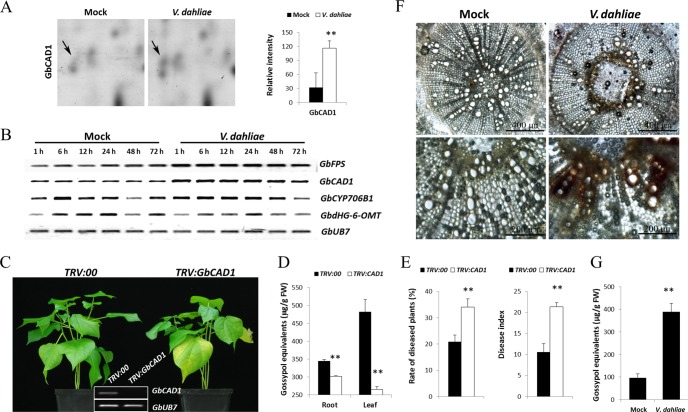Fig. 3.
Gossypol is involved in the resistance of cotton to V. dahliae. A, Shown are representative protein spot (GbCAD1) on inoculation with V. dahliae and quantification of the signal intensities obtained from three independent 2-DE maps. Error bars represent the standard deviation of three biological replicates; asterisks indicate statistically significant differences, as determined by the Student t test (**p < 0.01). B, RT-PCR analysis of gossypol biosynthesis-related genes at the transcriptional level in G. barbadense cv7124 on inoculation with V. dahliae. PCR was performed by 28 cycles of amplification for GbUB7 and 29 cycles for other genes. GbFPS, farnesyl diphosphate synthase; GbCYP706B1, cytochrome P450 mono-oxygenase. C, Disease symptoms induced on empty vector control (TRV:00) or GbCAD1-silenced (TRV:GbCAD1) cotton plants after inoculation with V. dahliae strain V991. Ten-day-old G. barbadense cv7124 seedlings were hand-infiltrated with Agrobacterium carrying individual genes in the VIGS vector. Two weeks after infiltration, the seedlings were dip-inoculated with V. dahliae. Photos were taken at 12 d after inoculation. D, Accumulation of sesquiterpene aldehydes (gossypol equivalents) of control (TRV:00) and GbCAD1-silenced (TRV:GbCAD1) cotton plants. The roots and leaves of control and GbCAD1-silenced cotton plants were collected for sesquiterpene aldehydes extraction and quantitation 12 d after VIGS-infiltration. Error bars represent the standard deviation of three replicates (n = 12); asterisks indicate statistically significant differences, as determined by the Student t test (**p < 0.01). E, Rate of diseased plants and disease index measurement of control (TRV:00) and GbCAD1-silenced (TRV:GbCAD1) cotton plants after inoculation with conidial suspension of V991. The rate of diseased plants and disease index were measured at 4 d after the plants beginning to present disease symptoms. Error bars represent the standard deviation of three biological replicates (n ≥ 16); asterisks indicate statistically significant differences, as determined by the Student t test (**p < 0.01). F, Detection of gossypol accumulation in cotton roots inoculated with V991. Radial sections of uninfected cotton roots display less orange-staining gossypol than infected cotton roots. Scale bars: 400 μm and 200 μm, respectively. G, Accumulation of sesquiterpene aldehydes (gossypol equivalents) of G. barbadense cv7124 inoculated with V991. After inoculation with V991 for 5 d, the Mock and infected roots of 7124 were harvested for sesquiterpene aldehydes extraction and quantitation. Error bars represent the standard deviation of three replicates (n = 12); asterisks indicate statistically significant differences, as determined by the Student t test (**p < 0.01).

